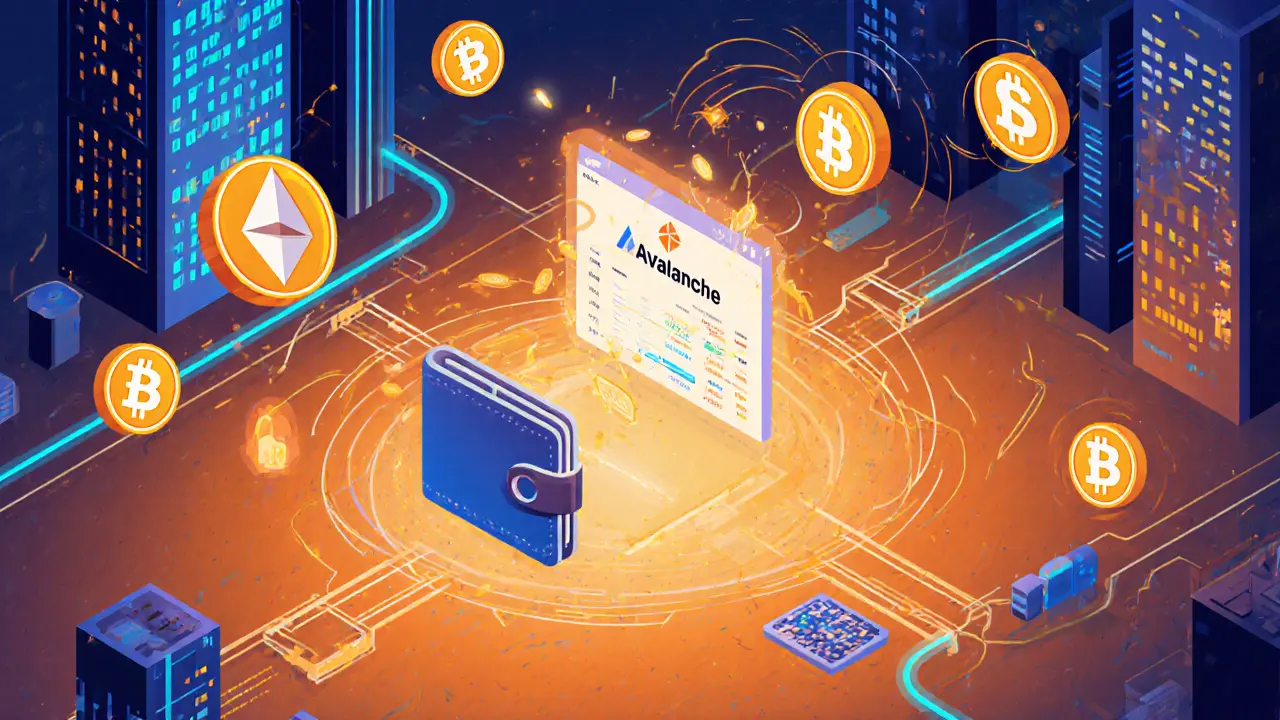LFJ v0 Trading Fee Calculator
Calculate Your Trading Costs
Compare fees across exchanges for your trade amount
Note: Fees shown are based on LFJ v0's standard rates. Gas fees are included in your calculation.
If you’re trading crypto on Avalanche, you’ve probably heard of LFJ v0 - also known as Trader Joe. It’s not just another decentralized exchange. It’s the second-largest DEX on Avalanche, handling over $127 million in trades every day. But is it still worth using in late 2025, especially with newer platforms popping up? Let’s cut through the noise and look at what LFJ v0 actually does, how it performs, and who it’s really for.
What Is LFJ v0, Exactly?
LFJ v0 is the original version of Trader Joe, built specifically for the Avalanche blockchain’s C-Chain. It launched in 2021 and hasn’t changed its core design since - no mobile app, no major redesigns, just steady improvements. Unlike centralized exchanges like Binance or Coinbase, you don’t sign up, verify your ID, or hand over your keys. You connect your wallet - usually MetaMask - and trade directly. No middleman. No KYC. That’s the whole point.
The platform supports over 1,135 tokens, mostly on Avalanche, but also on Ethereum, Arbitrum, BNB Chain, Solana, and a few others. That’s a lot, but not as many as Uniswap on Ethereum. What it lacks in token count, it makes up for in speed and cost. Avalanche’s consensus mechanism - called Snowman - lets it finalize transactions in under a second. That’s faster than most banks.
How Much Does It Cost to Trade on LFJ v0?
Fees on LFJ v0 are simple: 0.3% for regular swaps. That breaks down to 0.25% going to liquidity providers and 0.05% to JOE token stakers. But here’s the kicker: if you swap using the native JOE token, you pay zero fees. Same goes for AVAX - you only pay 0.1% instead of 0.3%. That’s a big deal if you’re trading frequently.
Compare that to Uniswap v3 on Ethereum, where gas fees alone can run $1.75 per trade. On LFJ v0, even during peak times, you’re looking at $0.05 to $0.15 in gas. That’s not a typo. It’s under 15 cents. That’s why so many retail traders stick with it - you can make dozens of small trades without burning through your balance.
Limit orders cost 0.2%, which is still cheaper than most centralized exchanges for small traders. But there’s no volume-based discount. If you trade $50,000 a month, you don’t get a lower rate. That’s a gap compared to Binance, where high-volume traders pay as low as 0.015%. For institutions, that’s a dealbreaker. For everyday users? It doesn’t matter.
Performance and Speed: Faster Than You Think
LFJ v0 doesn’t just claim to be fast - it proves it. According to JustScreener’s 2025 benchmarks, average swap times are 0.87 seconds. During market spikes, when Ethereum DEXs freeze, LFJ v0 keeps rolling. One Reddit user swapped 25 AVAX for USDC in 0.9 seconds while Uniswap took 27 seconds. That kind of speed matters when you’re trying to catch a pump or avoid a dump.
Avalanche’s architecture gives it an edge. It uses three chains: X-Chain for assets, P-Chain for validators, and C-Chain for smart contracts. This setup lets it handle 4,500 transactions per second. Ethereum can’t touch that. Even Solana, known for speed, has had three major outages since 2023 that cost users over $8 million. LFJ v0? Zero protocol-level exploits. That’s rare in DeFi.
Slippage is adjustable up to 12%, but experts recommend 0.5% for stablecoins and 1-3% for volatile tokens. A common mistake? Users reset their slippage after a browser update and end up with failed trades. Always double-check it before hitting confirm.
Security: Audited, Time-Locked, and Clean
Security on LFJ v0 isn’t an afterthought. The smart contracts were formally audited by OpenZeppelin in 2021 (report AVAX-LFJ-2021-001). That’s a gold standard. But the real win is how upgrades work. Any change to the code requires a 48-hour public review period. That means no surprise patches, no rug pulls. The team can’t just steal funds - they’d have to convince the whole community first.
The September 2025 update (v0.3.7) fixed a critical slippage bug found by Trail of Bits (CVE-2025-7321). That’s a good sign - the team responds fast when issues arise. No major hacks. No exploits. Just steady maintenance.

What’s Missing? The Big Downsides
LFJ v0 isn’t perfect. The biggest complaint? No mobile app. As of October 2025, there’s still no iOS or Android version. That’s a huge problem. Over 68% of crypto users trade on their phones, according to Triple-A’s 2025 report. Users on Trustpilot and Reddit say they’ve lost money because they couldn’t act fast enough. One person lost $1,200 on a JOE pump because they were stuck on a desktop.
Another issue: no cross-chain swaps. You can trade tokens from other chains - like ETH or SOL - but only if they’re already bridged to Avalanche. You can’t swap ETH for AVAX directly on LFJ v0. You have to use Avalanche Bridge (AB) first, which takes about 3 minutes and 22 seconds on average. That’s slow for crypto. And if the bridge goes down? You’re stuck.
There’s also no staking rewards for regular users - only for JOE holders who stake in the liquidity pool. And no educational videos. The guides are text-heavy. If you’re new to DeFi, you’ll need to spend 8-12 hours learning before you’re comfortable.
Who Is LFJ v0 For?
LFJ v0 is perfect for:
- Traders who want fast, cheap swaps on Avalanche
- Users who hate KYC and want full control of their funds
- People who trade AVAX, JOE, or Avalanche-native tokens daily
- Those who don’t mind desktop-only access
It’s not for:
- Mobile-first traders
- People who want to swap tokens across chains without bridging
- Institutions needing volume discounts
- Beginners who want hand-holding or video tutorials
How Does It Compare to the Competition?
Here’s how LFJ v0 stacks up against key rivals as of Q3 2025:
| Feature | LFJ v0 (Avalanche) | Uniswap v3 (Ethereum) | Raydium (Solana) | Pangolin (Avalanche) |
|---|---|---|---|---|
| Trading Volume (Daily) | $127M | $1.2B | $89M | $98M |
| Total Value Locked (TVL) | $842M | $5.1B | $420M | $1.2B |
| Avg. Swap Time | 0.87s | 13s | 1.1s | 1.2s |
| Avg. Gas Fee | $0.08 | $1.75 | $0.03 | $0.09 |
| Mobile App | No | No | Yes | No |
| Protocol Hacks (2023-2025) | 0 | 0 | 3 ($8.3M lost) | 0 |
| Cross-Chain Swaps | No | No | Yes | No |
LFJ v0 wins on speed and security. It loses on mobile access and cross-chain features. If you’re deep into Avalanche, it’s the best choice. If you want to trade across chains or use your phone, look elsewhere.

Getting Started: 5 Simple Steps
Here’s how to use LFJ v0 in 2025:
- Install MetaMask version 10.18.1 or newer.
- Add Avalanche Mainnet to your wallet:
- RPC URL: https://api.avax.network/ext/bc/C/rpc
- Chain ID: 43114
- Symbol: AVAX
- Block Explorer: https://snowtrace.io
- Fund your wallet with at least $1.50 worth of AVAX for gas.
- Go to traderjoexyz.com and connect your wallet.
- Approve tokens once - you’ll only do this the first time you trade a new asset.
That’s it. No sign-up. No email. No waiting.
What’s Next? LFJ v2.1 Is Coming
The team has confirmed that LFJ v0 is in maintenance mode. The real future is LFJ v2.1, launching in Q2 2026. It’ll include:
- A native mobile app
- Cross-chain limit orders
- Concentrated liquidity pools (like Uniswap v3)
- Tiered fee discounts based on trading volume
If you’re holding off because of the lack of mobile access, wait for v2.1. If you’re already trading on v0 and happy with the speed, keep going - v2.1 will still support your existing positions.
Final Verdict: Still a Top Pick for Avalanche Traders
LFJ v0 isn’t flashy. It doesn’t have a mobile app. It doesn’t let you swap ETH for SOL in one click. But it’s fast, cheap, secure, and reliable. For anyone trading on Avalanche - especially AVAX, JOE, or stablecoins - it’s still the best option in 2025.
The lack of mobile access is a real flaw, and the absence of cross-chain swaps is a limitation. But for what it does, it does it better than almost anyone else on its chain. With v2.1 on the horizon, it’s not going anywhere. If you’re serious about DeFi on Avalanche, you’re already using it. If you’re not? You should be.
Is LFJ v0 the same as Trader Joe?
Yes, LFJ v0 is the original version of Trader Joe, operating on Avalanche’s C-Chain. The name "LFJ" is shorthand used in technical circles, but the platform is widely known as Trader Joe. The v0 designation refers to its initial implementation and distinguishes it from the upcoming v2.1 upgrade.
Do I need AVAX to use LFJ v0?
Yes. You need AVAX to pay for gas fees on Avalanche. Even if you’re swapping other tokens, you still need a small amount of AVAX (at least $1.50 worth) to approve transactions. You can’t use USDC or ETH to pay for gas - only AVAX.
Is LFJ v0 safe to use?
Yes, as long as you follow basic crypto safety rules. The smart contracts have been audited by OpenZeppelin, and upgrades require community review. There have been no protocol-level hacks. But like all DeFi platforms, you’re responsible for your own keys. Never share your seed phrase, and always double-check token addresses before approving trades.
Can I stake JOE on LFJ v0?
You can’t stake JOE directly for rewards on LFJ v0. But you can provide liquidity to JOE/USDC or JOE/AVAX pools, and you’ll earn trading fees plus JOE rewards from the platform’s incentive program. This is called liquidity mining, and it’s how most users earn passive income on the platform.
Why doesn’t LFJ v0 have a mobile app?
The development team has prioritized stability and security over mobile development. They’ve stated that building a secure mobile wallet integration is technically complex and resource-intensive. Instead, they’re focusing on delivering a full mobile experience with LFJ v2.1, expected in Q2 2026. Until then, users must use desktop browsers.
Is LFJ v0 affected by MiCA regulations?
Currently, LFJ v0 is exempt from MiCA because it’s non-custodial and has no KYC. But MiCA requires all DeFi platforms serving EU users to comply with certain transparency and reporting rules by 2027. The team has acknowledged this and may add optional KYC for EU users or restrict access if needed. For now, no changes are planned.
What’s the difference between LFJ v0 and LFJ v2.1?
LFJ v0 is the original version: fast, simple, no mobile app, no cross-chain swaps. LFJ v2.1, launching in Q2 2026, will add concentrated liquidity pools, cross-chain limit orders, a native mobile app, and volume-based fee discounts. v0 will remain operational but won’t receive new features - all innovation is shifting to v2.1.
Next Steps
If you’re ready to try LFJ v0, start small. Deposit $20 in AVAX, swap it for USDC, then back again. Watch how fast it happens. Then try a limit order. See how easy it is to set a price and walk away. If it feels smooth, you’re already ahead of most crypto users.
If you’re waiting for a mobile app, bookmark the official roadmap. The v2.1 launch will change everything. But if you’re trading on Avalanche today? LFJ v0 is still the best tool in the box.
